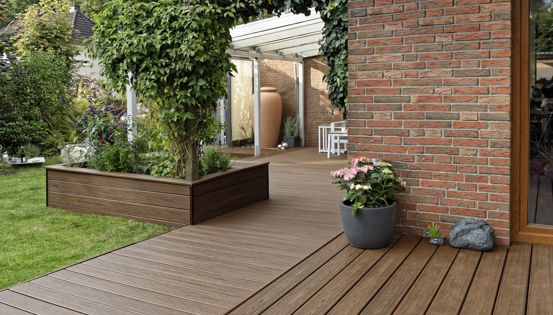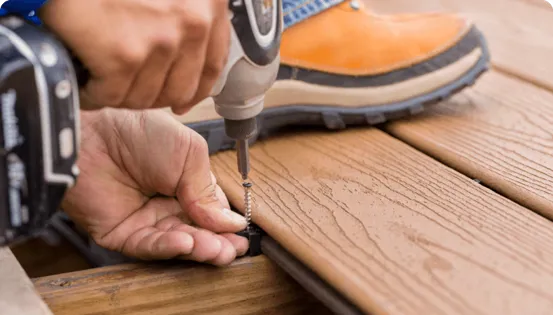Designing and building a deck suited to your wants and needs can be fun and exciting. But when it comes to care and maintenance, it’s important to know what you’re getting yourself into beforehand. Examine the pros and cons of composite or wood decking -- specifically when it comes to how to clean your decking. And in addition to routine cleaning, you should also be aware of other maintenance work you may need to do from time to time on your deck.
For natural wood lovers, properly cleaning a wood deck requires annual care. You can buy deck cleaning solution at your local hardware store or make your own homemade concoctions from various household products that are effective in fighting mildew, algae, oil and debris.
In addition to cleaning, you’ll also need to routinely stain or seal your natural deck to keep it looking fresh and protect it from the harsh effects of elemental damage -- mainly heat and moisture. In some cases, your natural wood deck may also splinter, requiring sanding or replacing loose boards from time to time.
Composite decks on the other hand, offer a lower level of all-around maintenance – they won’t splinter and you don’t need to worry about periodic staining, painting or sealing projects.
Let’s learn more about tackling cleaning and keeping your deck in great shape!
Deck Cleaning Solutions & Materials Needed
Washing your deck consists of scrubbing it with a deck cleaning solution and a stiff bristle brush. You will need a bucket, cleaner, garden hose with a water nozzle or power washer, and a brush with an extension pole – unless you want to be scrubbing on your hands and knees.
Additionally, there are a number of safe, homemade cleaning solutions you can use on your deck, regardless of whether you have a natural wood or composite deck. These ingredients can be purchased from your local hardware or general store.
Depending on which homemade recipe you follow and whether you’ve got a natural or composite deck, various proportions and combinations of the following items can help you keep your deck in top condition. They include:
- Warm water can be used on its own to wash a wood or composite deck.
- Liquid dish soap (ammonia-free) is safe for use on cleaning your deck when mixed with a little warm water. Simply mix 1 gallon of water, 2 tablespoons of ammonia-free dish soap (such as Murphy’s), 1 pint of rubbing alcohol, and 1 quart of oxygen bleach. Be very careful so that you use only ammonia free dish soap. Otherwise, if ammonia is mixed with bleach, it can create toxic fumes. Once you’ve blended your mixture, swab it on your deck and rinse it clean with water.
- Oxygen bleach or powdered oxygen laundry cleaner is safe for use on wood decks and useful in removing mold or spores. When cleaning your deck, make sure you only use oxygen bleach and not chlorine bleach, which can compromise the structural integrity of your wood deck.
- Vinegar - Safe for both composite and wood decking, mix a half-cup of white vinegar or apple cider vinegar to ¼ a cup of baking soda with 1 gallon of water.
How to Clean a Wood Deck
Natural wood decks have the potential to look great if they’re well-maintained. But the amount of summer wear and tear from cookouts and backyard fun combined with the harsh winter cold and frost can really do a number on a real wood deck over time, unless you stay on top of cleaning and caring for it.
Check out the steps below for how to properly clean wood decking:
- Step 1: Pre-rinse your deck
First, spritz the deck with water to soften the dried cellulose fibers. This 'pre-rinse' will also allow for the cleaning solution to be more easily dispersed throughout the deck. - Step 2: Mix your chosen solution
Mix your cleaning solution in a 5-gallon bucket with water following the instructions on the container. - Step 3: Scrub with the grain
Next you can begin to scrub the deck with the grain using your stiff bristle brush to remove dirt, mildew, mold, stains etc.
TIP: If the deck surface is large, mix and divide multiple batches of cleaning solution. The concentration of the cleaning solution should remain consistent throughout the project. - Step 4: Rinse thoroughly
You can then use your garden hose or a pressure washer to rinse the surface of the deck. Try to time your deck cleaning project for nice weather. It is best if you can allow your deck to dry for 24-48 hours before staining and sealing.
How to Clean a Composite Deck
On the other hand, when it comes to the best way to clean composite decking, the answer looks quite different from cleaning methods for natural decking. To maintain the beauty and functionality that you want from your deck, a little care and cleaning can go a long way.
The first step in your composite decking and care maintenance routine, is to stay away from certain household chemicals that a natural wood deck requires to stay looking new. Some of these harsher chemicals can damage the composite material, and no one wants to do more harm than good to their deck.
While composite deck cleaners are available, the actual composite deck cleaning process is convenient and simple enough that you can just as easily keep it looking fresh and clean with your own homemade composite deck cleaner.
All you need to make your eco-friendly composite deck cleaner is a little soap, water, vinegar and baking soda (for cases of mold) and a gentle pressure power washer (no greater than 3100 psi) and/or soft bristle brush to remove dirt, debris and other grime. It’s recommended that you administer a semiannual cleaning on your composite deck to preserve its longevity.
- Step 1: Pre-spray your deck
For how to clean composite decking DIY, start by spraying the deck off with a hose and water to remove any surface debris. - Step 2: Spray with soapy water & scrub
Then spray with soap, followed by gently scrubbing each deck board with a soft bristle brush. - Step 3: Rinse thoroughly
After you’ve put a little elbow grease into scrubbing, go ahead and rinse the deck thoroughly.
TIP: This is important because if dirty water from the cleaning is left and dries, a thin film may remain on the composite surface.
Removing mold from your composite decking
For mold removal, try cleaning composite decking with vinegar.
- Step 1: Pre-rinse
Use your hose or power wash to remove as much of the surface mold as possible. - Step 2: Mix your vinegar solution
Next, mix two parts vinegar and one part water into a bucket. Pour the solution directly on the mold. - Step 3: Sprinkle baking soda
After the solution is poured, sprinkle some baking soda on the area well. Let the compound sit and soak for 20 minutes and then scrub the area with your gentle bristle brush to remove any leftover mold and mildew. - Step 4: Rinse thoroughly
Finally, thoroughly wash the area clean to avoid leaving a layer of film.
And that’s it! With just a little soapy water, some gentle pressure, and the cleaning tips for composite decking or wood decking above, you can keep your deck clean and in peak condition. That’s what we call maximum outdoor living with minimal maintenance!







